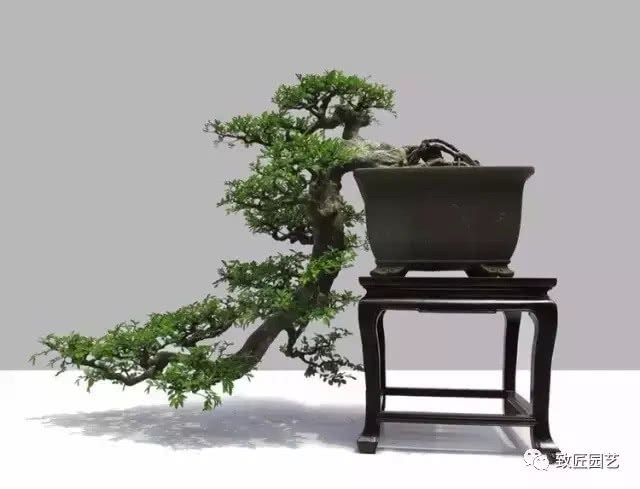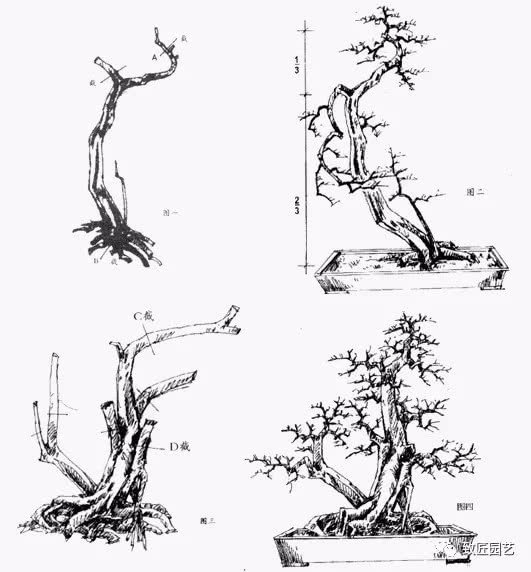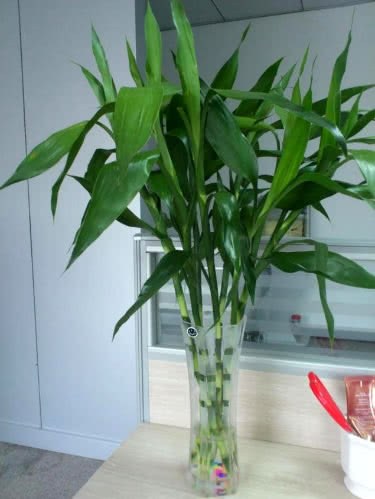Dialectics and Aesthetics in the production of Bonsai

Everything contains contradictions, and contradictions are unity of opposites. Under certain conditions, the two sides depend on each other and live together in unity as the premise of each other, which is also the ideological principle of bonsai production.
1. Virtual and real: the proper handling of the relationship between virtual and real will make the artistic conception of bonsai more beautiful and lofty. The position of a connoisseur is mentioned in the book, but if it is dense, the charm will be reduced. If the clouds fall into haze, there will be a living machine. When it comes to painting, if there is no virtual and real change, it cannot be regarded as a successful work, and if the virtual and real is handled properly, the flexibility of the painting will be greatly increased, it will be interesting, and so will the bonsai production, which is the basis and basis of the virtual. The virtual is the residual meaning and expansion of the real, but the virtual gives people the associative effect, so the branches and leaves should have the virtual and real changes when making the bonsai, and when the virtual is not virtual, the realm is blocked but not stretched. When the reality is not real, the realm is empty and has no content, but there should be a certain degree of emptiness and moderation, and if it is excessive, it will be scattered. Only by ingenious combination of virtual and real can we complement each other. This is the traditional way of expression in our country, which is more important in the jungle bonsai. Therefore, virtual and real is an important artistic treatment method in the management position. It gives people the artistic effect of "words are full but meaning is endless". It is of great significance to the production of bonsai artistic conception. For example, if there are more branches on one side and exaggerated branches on the other, the gap is larger, and there is only one branch, which is a virtual treatment, and it is this side that gives people the feeling of a big valley under the tree and a good mountain and river out of sight in the distance, which fully proves its role in expanding the artistic conception in the management position.
two。 Density: emptiness and reality has an impact on meaning, while density is a very important aspect for the arrangement of bonsai shaped branches. In general, the pile scene should be dense on top and bottom, and the distribution of branches on the pole should also be sparse and dense. They should not be stereotyped, and they should not know the end. In the painting theory, there is a sense of closeness and emptiness, which can make the whole work rich in change in form and feel lofty and green, such as towering and green. The lower branch is larger than the upper branch and the space distance is larger and more sparse, while above the opposite side of the extended branch, the branches are more dense, which makes the whole shape relaxed moderately and the image tall.
3. Primary and secondary: primary and secondary in the bonsai trend is very important, in the image combination should be divided into primary and secondary, generally mainly deal with the prominent position in the scene, can also be broken on the side, but the momentum should be focused on the main scene, it can make the viewer's vision focus on the wonderful main scene, how to deal with the primary and secondary key in cooperation to achieve primary and secondary, secondary to let the primary and secondary, double dry style should manage the primary and secondary issues, such as seven steps of poetry The trunk is thicker and taller than the secondary trunk, the trunk potential is larger and spicy, indulgent, and the secondary trunk is thinner. When echoing the trunk, it extends sideways and makes concessions according to the development of the trunk, but it supplements the space left by the trunk, and the two do not interfere with each other in the growth of the branch. in addition, there is also a primary and secondary relationship between the bonsai, such as the sub-branch in [Yunli Zangjiao], which only grows in the gap left by the growth of the trunk and echoes with the trunk. It is like a part of the main scene extending a big branch, which finally makes the whole shape form its own game in terms of potential.
4. Hidden dew: Guo Xi, a great painter of the Song Dynasty, said that if the mountain wants to be high, the haze is high, the haze lock its waist is high, the small desire is far away, and the pulse is far. " If you want to make the painted mountain very high, draw a cloud on the hillside to block part of the mountain, and the mountain looks high, while painting a long river makes it seem more distant. In bonsai production, Zang can build up momentum, strengthen suspense, stimulate the viewer's imagination and produce a lofty artistic conception, so there are often places where hiding is better than exposure, expressing more, deeper and farther. If there is no Tibet, there is no rhyme, so it is difficult to think deeply, so there is a saying: Xiaoqing has no fish, so the organic combination of hiding and dew can deepen the theme and strengthen the artistic conception, resulting in the artistic effect of "half-covering the shy face with the pipa". If the stem is divided into three trunks less than a foot from the ground, it seems very unnatural to leave saw marks on two trunks and dry here steeply and thinly. In dealing with this problem, it is adopted to leave more edges here and deal with it more solidly, so that the finer stem above is connected with the lower root stem through this shield, so that the pile scene which is less than two feet high appears towering into the clouds, looks up to the top, and achieves a better artistic effect.
5. Curved straight: curved straight is the most basic form of change in bonsai modeling. The curve contains more content and changes, making the branches stretch and smooth and dynamic, with the artistic effect of twists and turns. The Chinese totem is a dragon. This thing with s-shape makes people feel noble and magical. In the old days, bonsai was beautiful in music, but straight without appearance. As a matter of fact, qu and Zhi are interdependent on each other under certain conditions, so qu and Zhi cannot exist independently, and their mutual transformation constitutes the rhythm in bonsai. On the other hand, qu is soft and straight, as if calligraphy should be straight, and the bend is curved. The bend is strong, otherwise it is powerless and lacks a sense of vigor. Beginners often bend every branch, resulting in chaos and disorder, and there are a group of snakes hanging trees, which is morbid and without beauty. Therefore, the correct handling of the straight relationship will make the works produce reasonable and unexpected artistic effects.
6. Movement and movement: this pair of contradictions are mainly expressed in bonsai. Only when there is movement, there is stillness, which shows liveliness, and stillness is supported by movement, so that the center of gravity will not be unstable because of movement, and the center of gravity will not be unstable because of movement. If there is no movement, the movement will be disorderly. If there is no movement, there will be chaos, and if there is no movement, there will be chaos. If I want to go back to the wind, a big branch will increase the dynamics of bonsai. But other branches near the trunk increase the stability of the center of gravity, which is quiet, so that the whole bonsai has momentum without losing balance, so it is dignified and stable. Cangjin.
In short, successful bonsai works should be ideological and artistic to a certain extent. It is reasonable for old bonsai artists to say that bonsai was written by literati, so bonsai makers should not constantly improve their literary accomplishment. In terms of bonsai art aesthetics, although they are different from place to place, they must naturally provide materials, follow the basic growth habits of plants and the posture formed in the natural struggle, and conform to nature. Roman Roland said well: "Nature is beautiful." For example, in the bonsai form, the waterfront type and the cliff type are the appearance of plants adapting to nature, while some deformities, strange shapes or some animal images forcibly shaped by human consciousness, and those with a nose and eyes are extremely unnatural. Even if there are trees shaped like some animals in nature, it is also between resemblance and dissimilarity. The words of the artist Baishi Old Man are the classic language of art. Resembling the viewer has no room for imagination, if not at all, the viewer will not give beauty to the appreciator according to imagination. The point of view in the bonsai production process is subjective, but it is a summary of people's long-term observation and understanding of nature. Bonsai makers should give themselves to nature, give beauty to the viewer, leave their skills to themselves, and constantly improve their skills.
Wonderful content
- Prev

How to determine the height of the cut-off pile
Most of the piles of landscape are wild stumps. If we want to select stakes that match the shape of bonsai, we must master some knowledge of pile selection: 1. It must be a tree species suitable for bonsai modeling. two。 Piles should have good roots and heads. Especially.
- Next

Is the rich bamboo yellow leaves cultivated in water? A little trick to throw two rusty nails turns green.
Generally speaking, hydroponic rich bamboo is easy to raise, and some flower friends' rich bamboo is soaked in water in a vase, and it is no problem to live casually for a year. Think about the rich bamboo worth 10 yuan a handful, it's quite cost-effective. Hydroponic rich bamboo, in.
Related
- Wuhan Hospital Iron Tree Blooming Result Was Instantly Frightened by the Gardener Master
- Which variety of camellia is the most fragrant and best? Which one do you like best?
- What is the small blue coat, the breeding methods and matters needing attention of the succulent plant
- Dormancy time and maintenance management of succulent plants during dormancy
- Minas succulent how to raise, Minas succulent plant pictures
- What are the varieties of winter succulent plants
- How to raise succulent plants in twelve rolls? let's take a look at some experience of breeding twelve rolls.
- Attention should be paid to water control for succulent plants during dormant period (winter and summer)
- Watering experience of twelve rolls of succulent plants
- Techniques for fertilizing succulent plants. An article will let you know how to fertilize succulent plants.

